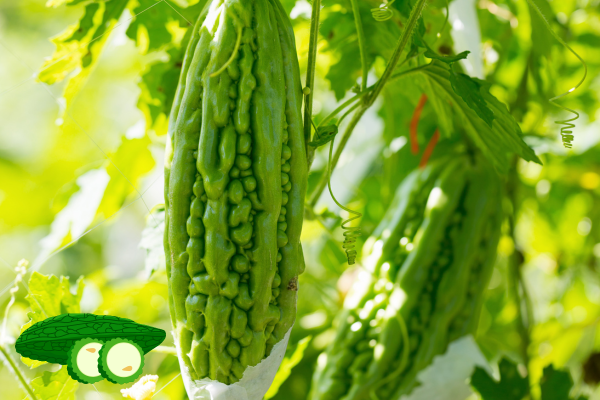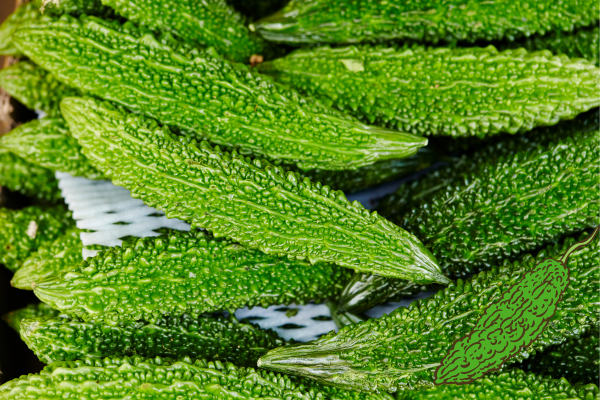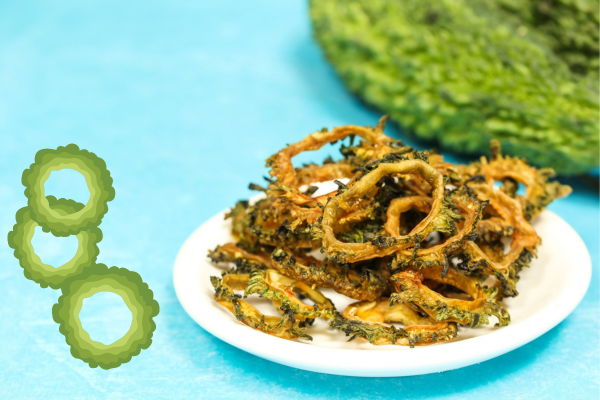Bitter Gourd (කරවිල) – By Nadeeka – eLanka

Bitter gourd, known scientifically as Momordica charantia and commonly referred to as Karavila in Sri Lanka, is a unique vegetable with a distinctive bitter taste. Despite its bitterness, it is celebrated for its numerous health benefits and versatility in cooking. This article delves deep into the health benefits of bitter gourd, provides detailed instructions on how to grow this plant, and explores various ways to cook and enjoy it, including a recipe for the traditional Sri Lankan dish, Karavila Sambal.
Health Benefits of Bitter Gourd
1. Rich in Nutrients
Bitter gourd is a powerhouse of essential nutrients. It is low in calories yet high in vitamins and minerals. A typical serving of bitter gourd provides:
- Vitamin C: Important for skin health and immune function.
- Vitamin A: Essential for eye health.
- Folate: Crucial for cell division and DNA synthesis.
- Potassium: Helps in maintaining proper heart function and blood pressure.
- Fiber: Aids in digestion and helps in maintaining a healthy gut.
2. Blood Sugar Regulation
Bitter gourd is well-known for its ability to help regulate blood sugar levels. Compounds like charantin, vicine, and polypeptide-p in bitter gourd have insulin-like properties, which can help in managing diabetes. Regular consumption of bitter gourd has been shown to improve glucose tolerance and reduce blood sugar levels in people with type 2 diabetes.
3. Antioxidant Properties
The high antioxidant content in bitter gourd helps in neutralizing free radicals in the body, thereby reducing oxidative stress and lowering the risk of chronic diseases such as heart disease and cancer. Antioxidants like vitamin C, beta-carotene, and flavonoids contribute to its health-promoting properties.
4. Immune System Support
Bitter gourd boosts the immune system, making it more effective at fighting off infections. The vegetable’s antimicrobial and antiviral properties help in preventing infections and keeping the body healthy.
5. Weight Loss Aid
Due to its low-calorie content and high fiber, bitter gourd is an excellent addition to a weight loss diet. It helps in promoting satiety, reducing appetite, and preventing overeating.
6. Skin Health
The antimicrobial and anti-inflammatory properties of bitter gourd make it beneficial for skin health. It can help in treating conditions like acne, psoriasis, and eczema. The high vitamin C content also aids in collagen production, which is essential for maintaining skin elasticity and preventing premature aging.
7. Liver Health
Bitter gourd acts as a liver tonic, improving liver function and detoxification processes. It helps in cleansing the liver, protecting it from damage, and improving overall liver health.
8. Digestive Health
The fiber in bitter gourd aids in digestion and helps in preventing constipation. It promotes regular bowel movements and maintains a healthy gut environment.
How to Grow Bitter Gourd
Growing bitter gourd is relatively straightforward, making it a rewarding plant for home gardeners. Here’s a step-by-step guide:
1. Selecting Seeds
Choose high-quality bitter gourd seeds from a reputable supplier. There are several varieties of bitter gourd, so select one that is well-suited to your climate and growing conditions.
2. Soil Preparation
Bitter gourd prefers well-draining, fertile soil with a pH between 5.5 and 6.7. Prepare the soil by mixing in compost or well-rotted manure to enhance fertility and improve soil structure.
3. Planting Seeds
Sow seeds directly in the garden once the soil has warmed up, typically in late spring or early summer. Plant seeds about 1 inch deep and space them 12 inches apart. If you are starting seeds indoors, plant them in biodegradable pots 3-4 weeks before the last frost date.
4. Providing Support
Bitter gourd plants are vigorous climbers and require support to grow. Provide a trellis or fence for the vines to climb, which helps in better air circulation and sunlight exposure, reducing the risk of diseases.
5. Watering
Water the plants regularly, keeping the soil consistently moist but not waterlogged. Mulching around the plants can help retain soil moisture and suppress weeds.
6. Fertilizing
Feed the plants with a balanced fertilizer every 4-6 weeks to promote healthy growth. Avoid excessive nitrogen, as it can lead to lush foliage with fewer fruits.
7. Pest and Disease Management
Keep an eye out for common pests like aphids, fruit flies, and whiteflies. Use organic pest control methods, such as neem oil or insecticidal soap, to manage infestations. Regularly check for signs of diseases like powdery mildew and downy mildew, and treat promptly with appropriate fungicides if necessary.
8. Harvesting
Bitter gourd fruits are typically ready to harvest 2-3 months after planting. Harvest the fruits when they are young and tender, as they become more bitter with age. Use a sharp knife or pruning shears to cut the fruits from the vine, leaving a small stem attached.

Culinary Uses of Bitter Gourd
Bitter gourd is used in a variety of dishes across different cuisines. Despite its bitterness, it can be delicious when prepared correctly. Here are some popular ways to cook and enjoy bitter gourd:
1. Bitter Gourd Juice
Bitter gourd juice is a popular health drink known for its detoxifying properties. To make the juice, blend fresh bitter gourd with a little water, strain, and add a pinch of salt and lemon juice to taste.
2. Stir-Fried Bitter Gourd
Stir-fried bitter gourd is a simple yet flavorful dish. Slice the bitter gourd thinly, remove the seeds, and stir-fry with onions, garlic, and your choice of spices. Add a splash of soy sauce or tamarind for extra flavor.
3. Bitter Gourd Curry
Bitter gourd curry is a popular dish in Indian and Sri Lankan cuisine. The bitterness of the gourd is balanced with spices and coconut milk, creating a rich and flavorful dish. Serve it with rice or flatbreads.
4. Pickled Bitter Gourd
Pickled bitter gourd is a tangy and spicy condiment. Slice the bitter gourd and marinate in a mixture of vinegar, salt, sugar, and spices. Let it sit for a few hours before serving.
5. Bitter Gourd Chips
Bitter gourd chips are a healthy and crunchy snack. Slice the bitter gourd thinly, remove the seeds, and deep-fry or bake until crispy. Season with salt and your favorite spices.

Recipe: Karavila Sambal
Karavila Sambal is a traditional Sri Lankan dish that showcases the unique flavor of bitter gourd. Here’s how to make it:
Ingredients
- 2 medium-sized bitter gourds (Karavila)
- 1 large onion, finely sliced
- 2-3 green chilies, sliced
- 2 cloves of garlic, minced
- 1 tablespoon of Maldive fish flakes (optional)
- 1 teaspoon of mustard seeds
- 1 teaspoon of turmeric powder
- 1 teaspoon of chili powder
- 1 tablespoon of tamarind paste
- 1 tablespoon of coconut oil
- Salt to taste
- Freshly grated coconut (optional)
- A handful of curry leaves
Instructions
- Prepare the Bitter Gourd: Wash the bitter gourds thoroughly. Cut them lengthwise and scoop out the seeds. Slice the gourds into thin half-moons. Sprinkle with a little salt and set aside for 15-20 minutes to draw out some of the bitterness. Rinse and drain well.
- Fry the Bitter Gourd: Heat coconut oil in a pan over medium heat. Add the sliced bitter gourd and fry until golden brown and crispy. Remove from the pan and set aside.
- Temper the Spices: In the same pan, add a little more oil if needed. Add mustard seeds and let them splutter. Then add curry leaves, onions, green chilies, and garlic. Sauté until the onions are soft and translucent.
- Add Spices: Add turmeric powder and chili powder to the pan. Stir well to combine, and cook for a minute to release the flavors of the spices.
- Combine: Add the fried bitter gourd slices back into the pan. Mix well to coat the slices with the spices and onion mixture. Add Maldive fish flakes, if using.
- Season: Add tamarind paste and salt to taste. Mix well and cook for another 2-3 minutes until everything is well combined and heated through.
- Finish: If desired, add freshly grated coconut for added texture and flavor. Mix well and remove from heat.
- Serve: Serve the Karavila Sambal warm with rice or as a side dish to complement your meal.
Conclusion
Bitter gourd, or Karavila, is a remarkable vegetable with a wealth of health benefits, from regulating blood sugar levels to boosting the immune system. Growing bitter gourd is a rewarding experience, offering a continuous supply of fresh, nutritious produce. In the kitchen, bitter gourd’s unique flavor can be transformed into a variety of delicious dishes, with Karavila Sambal being a standout example. By incorporating bitter gourd into your diet, you can enjoy both its culinary versatility and its numerous health benefits. So, embrace the bitterness and discover the wonders of this extraordinary vegetable.







